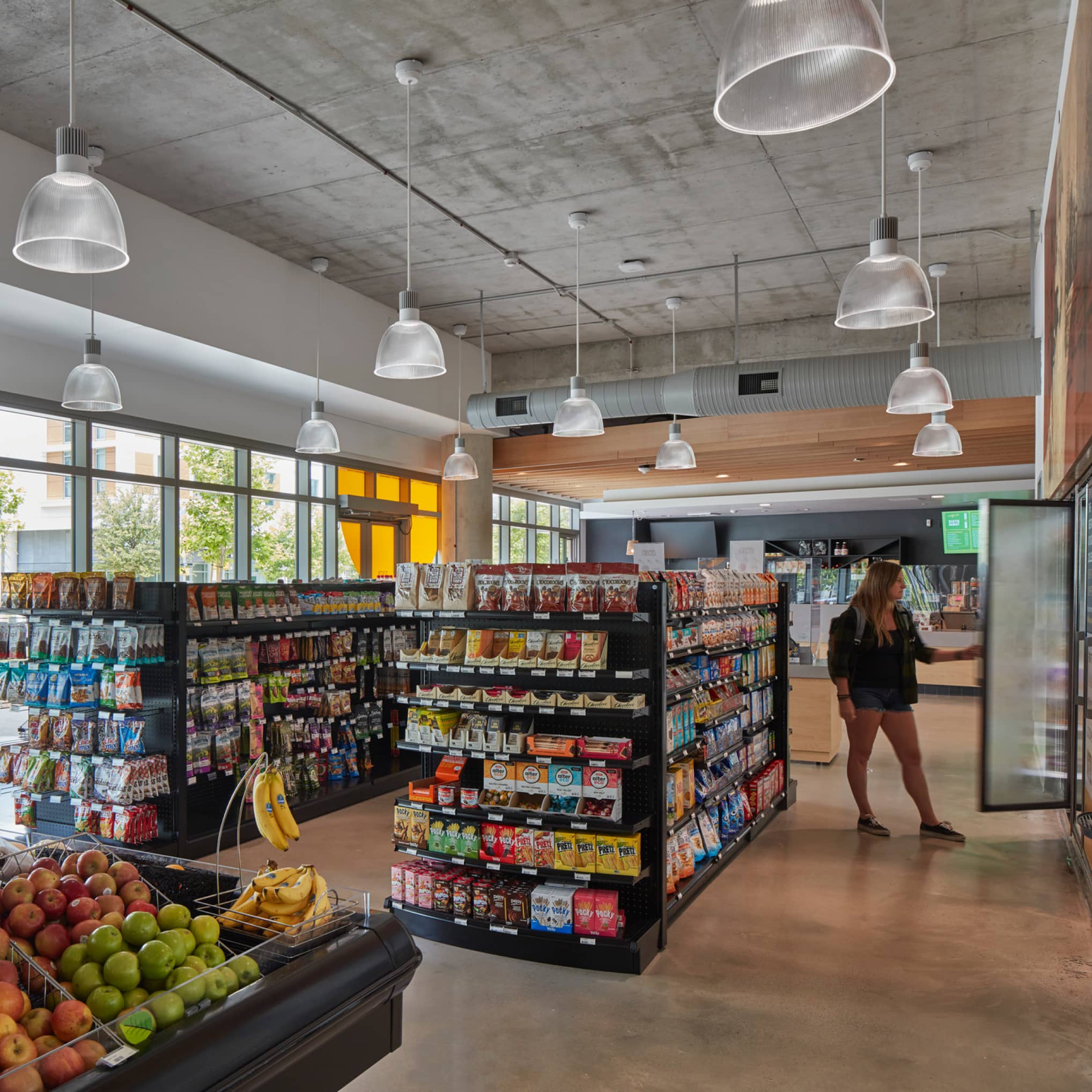
Can Design Help Curb College Drop-out Rates?
- Renae Mantooth, PhD
- HKS
According to College Atlas, 70 percent of Americans pursue studies at four-year colleges, but less than two-thirds earn a degree. Nearly one-third of college students drop out of college after their freshman year. Among the chief reasons students drop out or underperform academically is because of anxiety, depression and loneliness, which often stems from stressful or unengaging environments.
So, can a campus environment help combat isolation through design? How might a live-learn community on a large university campus make a difference?
From the moment our team — comprised of HKS, Clark Construction, Safdie Rabines Architects and OJB Landscape Architects — was awarded the North Torrey Pines Living and Learning Neighborhood (NTPLLN) at UC San Diego, we prioritized student health and well-being. We wanted to create a dynamic and welcoming place for many different types of people: the teenager experiencing their first time away from family; faculty and administrative staff responsible for guiding students during a formative period in their lives; and families and community members who visit.
The university’s Detailed Program Plan (DPP), a 1,400-page document created for competing teams pursuing the design-build competition, established a bold vision to create a fully integrated live-learn, mixed-use neighborhood nestled within UC San Diego’s sprawling 1,200-acre oceanfront campus in La Jolla, California. The largest construction project in school history, NTPLLN encompasses residence halls, academic buildings, faculty and administrative offices; below-grade parking and numerous amenities such as a market, two-story dining hall, expansive outdoor and public spaces, and the revival of the popular Craft Center, which closed in 2012.
Home to the university’s Sixth College, NTPLLN’s academic program includes the Social Science and Arts and Humanities departments. Founded in 2001, Sixth College prepares its students to become engaged 21st century citizens, offering rich and varied programs focused at the nexus of culture, art and technology.

The Neighborhood Takes Shape
During the project’s development, we interviewed students at the Sixth College who would eventually inhabit NTPLLN, asking them which elements of their environment contributed positively and negatively to their college life. We also used a persona mapping tool to understand the user experience from all points-of-view, which informed our design solution for each building type. Sixth College students said it was key that their culture of innovation and creativity be included in the design in a way that respects time-honored traditions while embodying future ideals: sustainability is a crucial tenet and aligns with UC’s system-wide initiative to be carbon neutral by 2025.
The main concept behind the design is simple and dates back to 6th century Greece planning schemes where dwellings, public amenities and learning buildings were often located near one another. We believe that students, faculty and administrators can experience a greater sense of community when their everyday tasks result in multiple interactions with each other. Starting with this basic organizing principle, we developed a design that reimagines the live-learn environment to align with the university’s vision and core values. And to make NTPLLN feel at home with the rest of the UC San Diego, we continued the traditional materiality found on campus, using exposed concrete and wood.
Due to the project’s density, we knew it would be critical to design for a human scale. The mixed-use neighborhood is organized around an active “main street” and to further develop a sense of community, we relied on the behavior mapping research we conducted that helped us put ourselves in the shoes of the college students whose valuable feedback we received.

We used the concept of nesting scales for the campus design, illustrated by considering a student’s bedroom and unit shared with suitemates as their home; the floor they live on — vertically connected to others in their building in a house style — as their community; Sixth College as their village, and UC San Diego and La Jolla as their city. We kept in mind how we could provide for meaningful social experiences at each of these scales.
When located adjacent to pedestrian areas, buildings more than four stories tall can feel intimidating, and we wanted the design to be a welcoming and accessible. Employing a dual scale design concept helped us minimize the actual and perceived magnitude of buildings throughout the neighborhood; those with podiums have stepped back towers from the lower podium facades, creating semi-private terrace rooftops for students and faculty to gather and enjoy access to the outdoors. Breaking up the verticality in this way also allowed us to create courtyards and varied building entry points.

Every residential building includes extensive natural ventilation and daylighting. Each floor is designed to provide both privacy and opportunities for social interaction and each student bedroom room is designed to feel like home. With 15 different housing configuration options, NTPLLN students could have a different living arrangement every semester of their academic career.
Academic buildings portray the distinct identities of the Social Sciences and the Arts and Humanities programs while maintaining shared connections among administrative staff via a shared outdoor entry plaza, courtyard and roof-top decks. Situated on the high point of the site, these buildings serve as a gateway and embrace the project’s dual scale theme on the campus grounds while providing natural daylight and fresh air to those inside.

A Place Where Well-being is Prioritized
NTPLLN opened to students for the Fall 2020 semester during the height of the COVID-19 pandemic. But well before the pandemic caused us to think even more critically about how living and learning spaces can impact our physical and mental well-being, we sought to make healthy, sustainable design decisions.
The team centered design strategies around the mental, social, and physical health of college students and others on campus using the Point of Decision Design (PODD) framework developed by the Center for Advanced Design Research and Evaluation (CADRE). PODD is defined as the use of well-planned ecological schemes and cues within the built environment to influence how individuals decide on participating in healthy activities at critical points of decision where they can have the most impact. The underlying principle is to make the healthy choice the easy one, by design.
PODD strategies are evident throughout NTPLLN. Making internal and external stairs inviting and providing visible spaces for play and exercise encourage movement, while dining options and convenient access to kitchens and rooftop gardens promote healthy eating. Accommodating bike racks, buses and micro-mobility solutions like skateboards, as well as an underground parking garage created a place where cars are not the “default” mode of transportation to and within the neighborhood.
We took advantage of San Diego’s temperate climate, creating places for outdoor living throughout. Each building in the neighborhood offers scenic coastal views and connections to the tropical climate to facilitate mental and physical wellness. Communal areas such as a rooftop vegetable garden provide opportunities for healthy habit development and physical activities including gardening and fitness classes, and community kitchens on each residence hall floor encourage cooking and socializing. Even learning spaces with operable walls open up onto outdoor terraces.

Positive Design and Research Outcomes
For more than two decades, academic researchers have linked anxiety and depression among college students with external stressors concerning food, housing and transportation. Research has proven that when students must commute to campus, do not have proper nutrition, or experience financial constraints and familial demands, they are less likely to be able to concentrate in academic settings and less likely to graduate. Put another way, students who have significant personal and structural barriers preventing them from fully engaging in their academic and campus life tend to drop out more frequently.
At NTPPLN, we sought to remove as many of those barriers as possible. We hoped that the campus would be embraced by UC San Diego and the people of La Jolla, a place that would inspire ingenuity and invention, learning and growing. With affordable, healthy on-campus living and dining options and dynamic learning spaces, NTPLLN’s design has exceeded those initial hopes.
Pre-move and post-move occupancy evaluations conducted by a research coalition comprising the university, CADRE and HKS designers revealed that student satisfaction with Sixth College new buildings has demonstrably increased, compared with the college’s prior facilities. On-site observations, interviews and media reporting have illustrated that NTPLLN has become a new center of energy at UC San Diego. And retail and restaurant activity there is setting records that are causing the university to rethink all other food service options. Friday night student music concerts on the lawn and cookie baking pajama parties in the teaching kitchen are becoming new school traditions.
Sixth College students reported reduced rates of depression, despite the COVID-19 pandemic when college student anxiety and depression rates increased five percentage points in the U.S., according to the National College Health Assessment. Moderate, significant correlations were observed between well-being metrics related to life satisfaction and depression and physical environment metrics related to satisfaction with multiple types of campus spaces. The correlation between mental health and environmental satisfaction factors demonstrates that the design of the places where students live matters.
An engaging mixed-use community, North Torrey Pines Living and Learning Neighborhood is proving to be an environment that supports students’ holistic well-being and one that helps UC San Diego’s fulfill its mission to develop global citizens and environmental stewards. Based on our design and research outcomes, we believe that students who live and learn there are more likely to stay in school and achieve academic success on their path to becoming the next generation of civic leaders.


